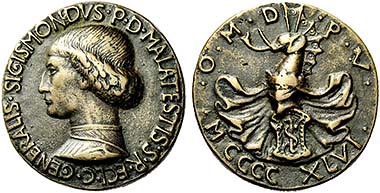
PREV ARTICLE
NEXT ARTICLE
FULL ISSUE
PREV FULL ISSUE
THE MEDALS OF SIGISMONDO MALATESTA
Ursula Kampmann published a nice article in CoinsWeekly about the renaissance medals of Sigismondo Malatesta. It's well illustrated and packed with great historical information - be sure to read the full article.
-Editor

After all, the Renaissance had completely changed the relationship between the ruler and the arts. Painters, architects and sculptors were now assumed to be the ones telling future generations about the individual's fame for centuries to come. The adequate medium had just been invented: the medal, an object of the minor arts, showing on one side the portrait of the person celebrated, on the other a motif that could provide a more detailed characterization of the one depicted. The production of a medal was inexpensive, at least much more inexpensive then the hitherto common pictures. The medal was easily repeatable and hence met the rulers' demand. They had a new means of propaganda which was able to publicize their portrait and their achievements quickly and relatively cheaply. The Malatesta family already was in close personal contact with the designer of the first Renaissance medal, Antonio di Puccio, called Pisanello. In 1433, he painted a portrait of the first wife of Sigismondo Malatesta. Approximately five years later, after the petition visit of the Byzantine emperor, John VIII Palaiologos, he had created the first medal. Shortly thereafter, most probably between 1444 and 1445, the medals by order of the Malatesta were produced.

The most famous medal for Sigismondo Malatesta was created by another great Renaissance artist, Matteo de'Pasti. In the meantime, when his wife had died, Sigismondo had married an illegitimate daughter of Francesco Sforza. At that time, he was at the height of his power. The year the medal's inscription states, 1446, was regarded by Sigismondo his lucky year: he won the Battle of Gradara, the Castel Sismondo, the fortress of Rimini, was completed, and he made beautiful, 13 year-old Isotta his mistress, daughter of a merchant from Rimini. No wonder, then, than a confident ruler of Rimini, wearing the armor of a military leader and a surcoat, proudly presents himself. Sigismondo Pandolfo Malatesta, captain-general of the Holy Roman Church – that was how this military commander called himself. The reverse likewise shows a motif indicative of war: an apparently invulnerable fortress, the Castel Sismondo in Rimini.
To read the complete article, see:
Sigismondo Malatesta – Condottiere and Ruler of Rimini
(www.coinsweekly.com/en/Article-of-the-week/5)
The Numismatic Bibliomania Society is a non-profit organization promoting numismatic literature. See our web site at coinbooks.org. To submit items for publication in The E-Sylum, write to the Editor at this address: whomren@gmail.com To subscribe go to: https://my.binhost.com/lists/listinfo/esylum All Rights Reserved. NBS Home Page Contact the NBS webmaster 
|